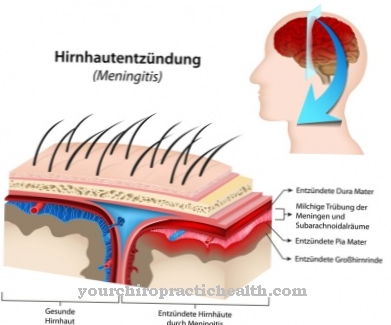The medical term Brachydactyly describes shortened fingers and toes. Usually inherited as an autosomal dominant disorder, this disorder belongs to the group of malformed limbs.
What is brachydactyly?

© Photographee.eu - stock.adobe.com
This genetic defect occurs either in isolation or as syndromes. The form can have a primary or secondary cause. It is also characterized by a bony dysostosis. Only types A3 and D occur more frequently. The other brachydactyly types are a rare phenomenon. The patient has one or more fingers that are shortened to varying degrees.
Nevertheless, doctors also use this term to summarize malformed and shortened toes. In some cases the metacarpal bones are also affected. This medical term goes back to the ancient Greek language and means "short finger". Are synonyms Brachymegalodactylism, Brachyphalangia such as Ossificatio praecox hereditaria.
causes
Brachydactyly is a malformation that occurs through inheritance within a family. A special form of Ossificatio praecox hereditaria is the autosomal dominant form of inheritance. The short fingers, however, rarely appear. The probability that people are affected is 1 in 200,000. Exceptions are types A3 and D. Brachydactyly is either isolated or syndromic.
In the first case, the hereditary disease is present without any further side effects, while in the second case it is due to a complex malformation syndrome. Some identifiable progression forms occur in combination with short stature. Even in the case of isolated brachydactyly, the finding is not easy, as it can be associated with subtle changes in other areas in the organism.
Other possible symptoms are hand malformations such as polydactyly, syndactyly, symphalangism or reduction defects. The research is now so far that the identification of the causally involved gene is possible for most isolated and sydromal forms. The isolated brachyphalangia is inherited as an autosomal dominant trait with different penetrance and expressivity in most cases.
Symptoms, ailments & signs
This malformation occurs in eleven forms and is divided into types depending on the extent of the shortening: A1 (Farabee), A2 (Mohr-Wriedt), A3 (Brachymesophalangia V), A4 (Temtamy), A5, A6 (Osebold-Remodini syndrome ), A7 (Brachydactyly Smorgasbord), B, C (Haws), D, E. Type B and E can occur in combination. A common occurrence of types A1 and B is also possible. Brachydactyly appears in different forms and forms.
Most patients show side-symmetrical short fingers. Sometimes entire phalanges are missing. Doctors differentiate this malformation according to certain characteristics, for example according to whether the fingers or toes alone are affected, or whether there are also malformations of other organs. This distinction is made because brachydactyly is either primary or secondary. In the primary, isolated course of the disease, there is only a malformation of the fingers or toes, without the influence of other clinical pictures.
In secondary, syndromic training, the shortenings are a result of certain previous illnesses, such as Aarskog-Scott syndrome (malformation of male sexual organs, abnormalities in the face and fingers), a hereditary disease that rarely occurs. In this case, brachydactyly is a secondary consequence of the initial illness. The most common form is type D. The last phalanx and fingernail are shortened. Most of the time, this thumb shortening occurs on both hands. In many cases, the big toe is also affected.
Diagnosis & course
The diagnosis is made through radiological and clinical examinations. In addition, the findings are supported by anthropometric measurements. If the isolated form of brachydactyly is present, there is no need for prenatal diagnosis. If there is a syndromic form, this form of prevention is indicated.
In this case, if a causal mutation is present, molecular prenatal diagnosis using chorionic villi (invasive prenatal biopsy) in the 11th week and amniocentesis (the amniotic sac is punctured to obtain aminocytes for diagnosis) in the 14th week is possible. Genetic counseling includes the type of disease that occurs in the family. The doctor advises the parents-to-be about the type of inheritance and the absence or presence of other symptoms.
The probability of developing brachydactyly type D is between 0.41 and 4.0 percent. This percentage depends on the population. 62 percent of the male affected show a reduced penetrance. This means that the genetic defect is less pronounced. The phenotype (appearance) of this hereditary disorder has only a reduced set of the characteristics that lead to the disorder.
Complications
Brachydactyly can usually appear in different forms and lead to different complications. The patient suffers from short fingers. However, it also happens that entire fingers are missing. In addition to the fingers, brachydactyly can also have a negative effect on other organs in the body and lead to malformations or defects in them.
In most cases, however, only the missing or malformed fingers appear and there are no further physical restrictions or complications. Brachydactyly can also cause malformations on the penis. In these cases, the patient's self-esteem is often reduced.
Those affected also suffer physically and mentally from the short fingers. With brachydactyly it is not possible to cope with everyday life normally. The sexual experience is also limited in men and can lead to depression and other psychological problems. Brachydactyly does not lead to a reduced life expectancy.
Direct treatment is not possible, but cosmetic operations can be performed if the patient so wishes. There are no complications here either. In severe cases, the function of the hand must be supported and treated with physiotherapy.
When should you go to the doctor?
In most cases, brachydactyly does not need to be diagnosed by a doctor.This complaint is visible immediately after the birth and is determined by the pediatrician. As a rule, brachydactyly cannot be treated. However, since brachydactyly can lead to severe restrictions and discomfort in the everyday life of the person affected, a doctor should always be consulted if there are developmental disorders in children. This can prevent further complications and difficulties in adulthood.
A doctor should also be consulted with psychological complaints or inferiority complexes in order to avoid depression, for example. Most of the patients are due to the brachydactyly also dependent on psychological treatment, which is given by a psychologist. The disease itself is diagnosed by the pediatrician. Physiotherapy can limit the individual complaints. The doctor should be consulted at an early age so that the person concerned can get used to the restrictions and learn to deal with them properly.
Doctors & therapists in your area
Treatment & Therapy
Classical therapy in the medical sense is not possible with brachydactyly. There is no specific form of treatment that can remedy all forms of this malformation. Plastic operations are only indicated for cosmetic reasons or if the hand function is severely restricted. If the typical forms are present, surgical interventions are not necessary, as those affected can usually live without discomfort with shortened fingers or toes.
Occupational therapy or physical therapy can help strengthen hand function and reduce the effects of shortening. The prognosis of the different types of brachydactyly depends on the type and extent and ranges from severe to minimal impairment. If the shortening is syndromic, the diagnosis and prognosis are determined by the accompanying anomalies.
Outlook & forecast
There is no chance of a cure for brachydactyly without medical care. The shortening or lack of bones on the hands and feet are genetic and last until the end of life. Therapeutic measures or drug treatment are also unsuccessful. For legal reasons, human genetics must not be altered and specific training units cannot change the structure of the bones.
Surgical interventions, on the other hand, are very promising and can lead to complete freedom from symptoms. This depends on the extent of the deformed bones. In order to achieve the best possible result, the procedure should be carried out after the growth process has been completed. Before the end of physical growth, the options for correction are usually not permanent. Other interventions follow in the course of life that increase the risk of complications.
In an operation, the bones can be lengthened and missing bones can be completely replaced. In many cases, the patient is then considered cured. Other patients still have to make use of therapies such as physiotherapy in order to learn how to optimally handle the changed limbs and how to move about them.
prevention
There is no way to prevent this deformity in the medical sense. Malnutrition or malnutrition, nicotine and alcohol during pregnancy and a generally unhealthy lifestyle can lead to malformations. Drugs and self-administered medication make the situation worse. Conversely, this means that a healthy and conscious lifestyle promotes healthy development.
You can do that yourself
So far there are neither conventional medical nor alternative methods to treat the cause of brachydactyly. However, those affected usually do not suffer from severe pain or other primarily physical disorders. For many sufferers, however, brachydactyly is associated with a considerable reduction in quality of life for psychological reasons. Patients with short or missing toes often avoid all situations where they have to show their feet bare. They consider water sports and beach holidays to be taboo.
If the person concerned suffers mentally or severely, they should consider the possibility of cosmetic surgery and seek advice from a plastic surgeon who specializes in aesthetic procedures on the hands and feet.
Those affected have to pay for purely cosmetic operations themselves. If a person suffers severely from brachydactyly, but also emotionally, the health insurance companies usually cover the costs. In any case, those affected should discuss this with their health insurer in advance.
If cosmetic surgery is ruled out, those affected can learn to deal with their impairment better and to break down complexes within the framework of psychotherapy. Very often one's own physical deficit is completely exaggerated and has no relation to the actual disability.
If brachydactyly is associated not only with aesthetic but also with functional limitations, physiotherapy is also helpful.

.jpg)
.jpg)





















.jpg)



